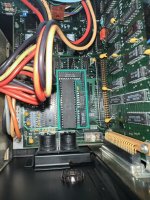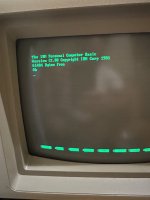chris_nh
Experienced Member


SCP-220A ?? Curious if anyone knows what this could be for? 8088 CPU module of some type with 74LS chips and a little pin header. Hmmm... can't seem to find any info about this. (pics from ebay listing, not mine)


My guess is that it is designed to look for appearance of a specific range of 8-bit addresses. One of the inputs is pulled high, one is connected directly to A10 at the 8088, five are connected to outputs of the hex inverter, and I cannot figure out what the 8th input is connected to.I'm having problems trying to figure out what an 8-input NAND is for.
From bill at booster.bothell.washington.edu Sat Jun 7 18:09:40 1997
From: bill at booster.bothell.washington.edu (Bill Whitson)
Date: Sun Feb 27 18:28:15 2005
Subject: Seattle Computer CPU Module
In-Reply-To: <3398F9A2.20B8@rain.org>
Message-ID: <Pine.ULT.3.91a.970607155743.29473D-100000@booster.bothell.washington.edu>
I was hoping someone wlse would know, but I'll do my best.
> In my travels, I picked up a dozen or so Seattle Computer CPU modules,
> model 220A. Basically, it is a circuit board about 1.5" x 3" with an
> 8088, SN74LS04, SN74LS30, and a SN74LS273 chip on it. It has an 8 pin
> header on the component side of the board, and the 40 pins of the 8088
> socket extend about .5" below the board. Does anyone here have any idea
> what this is??? I have had them for several years and have yet to find
> out where they were used. Thanks.
This info was obtained second hand from a guy I bought a bunch of
SCP stuff from. Apparently a one-time friend of his work for them.
Thus - this could be wrong. SCP made at least six models of computer
the first being Z80 machines which ran CP/M, the next few being 8086
based which ran CPM-86 or SCP-DOS (which I'm pretty sure is MS-DOS
1.0 or the immediate prdecessor purchased by MS). The last were 8088
PC-clone type machines. We're concerned with the 8086 machines which
apparently were equipped to take a coprocessor so as to run both
CP/M-86 and SCP-DOS/MS-DOS simultaneously. I missed buying such a
machine by 15 minutes :(. At any rate - I'm guessing you have a
bunch of 8088 co-processors for these machines. The one I missed
was called a Gazelle-I so they might be for that machine.
Too bad I missed the machine - but I did pick up everything else the
guy had. Came down to a stack of Shugart 8" drives, some CompuPro
S-100 boards and a whole bunch of SCP disks. Now that I've brought
it up - SCP-DOS 1.0 = MS-DOS 1.0? I'm pretty sure it is because
another disk I've got is labelled the same but says SCP/MS-DOS v1.25.
Bill
----------------------------------------------------
Bill Whitson - Classic Computers ListOpSo I just found a couple of mentions about this board at the link below. It mentions possibly a co-processor module for a Gazelle? Interesting...
Code:From bill at booster.bothell.washington.edu Sat Jun 7 18:09:40 1997 From: bill at booster.bothell.washington.edu (Bill Whitson) Date: Sun Feb 27 18:28:15 2005 Subject: Seattle Computer CPU Module In-Reply-To: <3398F9A2.20B8@rain.org> Message-ID: <Pine.ULT.3.91a.970607155743.29473D-100000@booster.bothell.washington.edu> I was hoping someone wlse would know, but I'll do my best. > In my travels, I picked up a dozen or so Seattle Computer CPU modules, > model 220A. Basically, it is a circuit board about 1.5" x 3" with an > 8088, SN74LS04, SN74LS30, and a SN74LS273 chip on it. It has an 8 pin > header on the component side of the board, and the 40 pins of the 8088 > socket extend about .5" below the board. Does anyone here have any idea > what this is??? I have had them for several years and have yet to find > out where they were used. Thanks. This info was obtained second hand from a guy I bought a bunch of SCP stuff from. Apparently a one-time friend of his work for them. Thus - this could be wrong. SCP made at least six models of computer the first being Z80 machines which ran CP/M, the next few being 8086 based which ran CPM-86 or SCP-DOS (which I'm pretty sure is MS-DOS 1.0 or the immediate prdecessor purchased by MS). The last were 8088 PC-clone type machines. We're concerned with the 8086 machines which apparently were equipped to take a coprocessor so as to run both CP/M-86 and SCP-DOS/MS-DOS simultaneously. I missed buying such a machine by 15 minutes :(. At any rate - I'm guessing you have a bunch of 8088 co-processors for these machines. The one I missed was called a Gazelle-I so they might be for that machine. Too bad I missed the machine - but I did pick up everything else the guy had. Came down to a stack of Shugart 8" drives, some CompuPro S-100 boards and a whole bunch of SCP disks. Now that I've brought it up - SCP-DOS 1.0 = MS-DOS 1.0? I'm pretty sure it is because another disk I've got is labelled the same but says SCP/MS-DOS v1.25. Bill ---------------------------------------------------- Bill Whitson - Classic Computers ListOp
The SCP-210 had a coprocessor socket - intended for an 8087, but we don't know if they made other changes to accommodate a daughterboard.If it's a downgrade module (8088 module to run in 8086 socket?), I first wonder if it would it work in any 8086 socket, or if the header pins need to be connected to something(s) for operation. If so, I was looking at pictures to see if I could discern an obvious place to connect on the SCP-200 or SCP-210, and there's nothing definitive to tell from the pictures, but I suppose it could connect somewhere on the SCP-210. Strange downgrade perhaps and probably not a big seller??The CPU is 5mhz, which doesn't fit the speed of the cpu boards, except for the SCP-200 at 4mhz? I understand the SCP-200 also ran at 8mhz, and the SCP-210 is either 8 or 10mhz.
Also interesting to note, the 8087 add on board is SCP-910A rather than something like scp-20x or 21x... SCP part numbers are interesting and I have yet to find a list.


